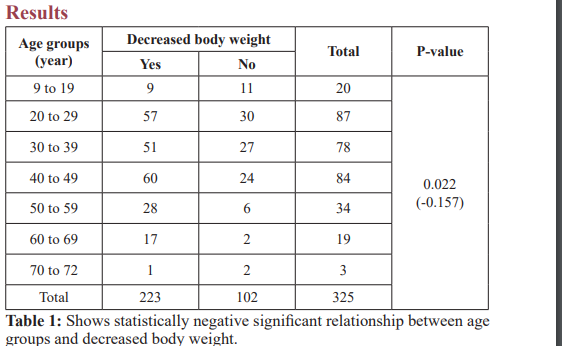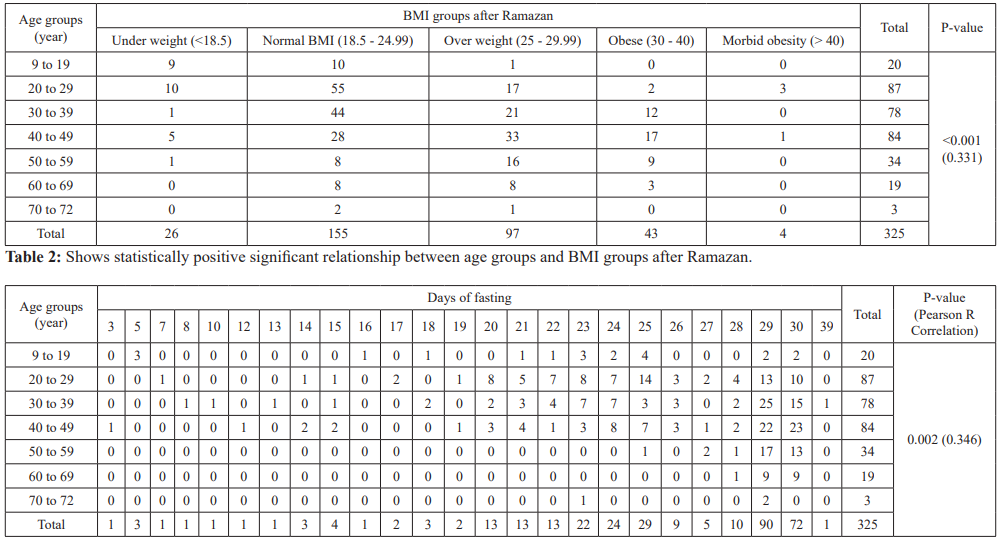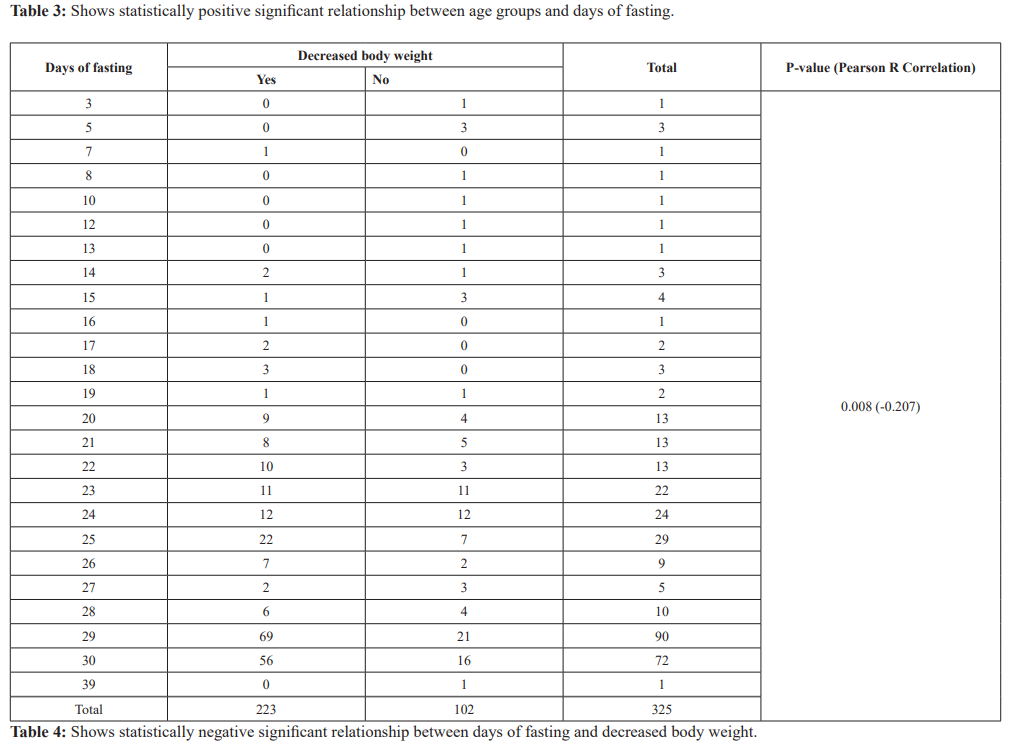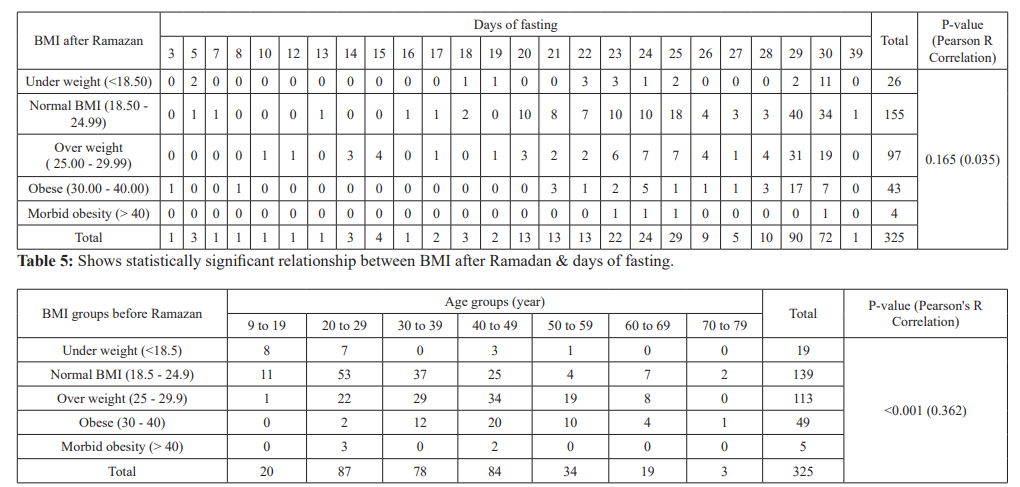Effect of Ramadan Fasting on Obese, Overweight & Normal Weight Persons with or Without Suhur (Parshew)
Author'(s): Dr. Ahmed Saeed1, Dr. Abdullah Sherif Abdullah2, Dr. Zana Nasraddin Mohialdeen3, Muhsin Abubakir4, and Dr. Sokar Ahmed Omer5
1MBChB-Diploma in Medicine, Kurdistan Board Emergency Medicine, Sulaimaniyah Directory of Health, Iraqi Kurdistan Ministry of Health, Iraq.
2MBChB, FICMS, Internal Medicine, University of Sulaimaniyah College of Medicine, Iraq.
3MBChB, HDGS, MRCS-Ireland, Sulaimaniyah Polytechnic University, Department of Anaesthesia, Iraq.
4MBChB-FICMS, Kurdistan Board GEH, Kurdistan Center for GEH, Iraq.
5M.B.Ch.B, Iraqi Internal Medicine Board Candidate, Iraq.
*Correspondence:
Dr. Zana Nasraddin Mohialdeen, MBChB, HDGS, MRCS-Ireland, Sulaimaniyah Polytechnic University, Department of Anaesthesia, Iraq.
Received: 18 December 2019 Accepted: 10 January 2020
Citation: Ahmed Saeed, Abdullah Sherif Abdullah, Zana Nasraddin Mohialdeen, et al. Analgesic Safety of Periodic Intravenous Infusion of Acetaminophen After Hepatectomy: A Propensity Score Matching Analysis. Gastroint Hepatol Dig Dis. 2020; 3(1): 1-5.
Abstract
Background: Ramadan is a holy month for Muslims around the world, during which healthy adult Muslims abstain from eating, drinking and smoking from dawn(sunrise) to sunset (Iftar). In this study, we aimed to evaluate the effect of Ramadan intermittent fasting on the body weight.
Subjects and Methods: This cross-sectional study was conducted during Ramadan from May-27th – May 2018. Three hundred and twenty-five volunteers from both genders were randomly selected, most of them were medical staff of our hospital. The volunteers were divided into normal body weight (BMI= 18.5-24.9), overweight (BMI=25-29.9) and obese (BMI= ≥ 30). weight and body mass index measured by the same scale on the last day of Ramadan. Were recorded Apart from weight other data collected from our participants like age, Gender, using medication or not, those who did Fasting with or without Suhur (Parshew) & those who did regular physical exercise or not during Ramadan.
Results: Most patient who were over-weight and obese were in the middle age group and those patients had more significant weight loss during Ramadan proportional to the number of days they fasted specially those had no Suhur meals.
Conclusion: Ramadan intermittent Fasting led to a statistically significant decrease in body weight and body mass index in the majority of the participants.
Keywords
Introduction
Religious fasting has been used for purification and transcendence, among other reasons. The three major Western religions — Christianity, Islam, and Judaism — all encourage some form of fasting as a part of their rituals [1,2]. Ramadan is a period during which healthy adult Muslims are expected to refrain from eating, drinking, smoking, sexual activity from dawn to dusk [3] and also abstain from taking oral medicine, intravenous fluid from dawn to sunset [4,5]. Fating exceptions include children, menstruating, pregnant, lactating women, sick (for whom fasting would be detrimental), and those who are traveling [6,7]. Normally every individual fast for 29 or 30 days from 13 to 18 hours per day depending on seasonal conditions or geographical location, Hence, the effect of Ramadan fasting may differ between countries [9,10]. Islamic fasting is an intermittent fasting (Ramadan intermittent fasting), but differs from other inter-mittent fasting models [11,12]. Studies suggest that intermittent fasting (IF) has beneficial effects on health [13,14]. Two meals are consumed daily: one before dawn, known as “sahour” followed by a long fast and one just after sunset, called “iftar” [9]. It has been established that a given nutrient ingested at an unusual time can induce different metabolic effects [15].
Overweight and obesity are major contributors to global disease burden [16] and are associated with increased risk of hypertension, coronary heart disease, type 2 diabetes, metabolic syndrome, elevate plasma lipid and inflammatory mediators’ levels, stroke, gallbladder disease, many cancers, osteoarthritis, sleep apnea, and many others, all can be improved through weight loss or, at a minimum, no further weight gain [17-19]. The prevalence of obesity is increasing in developed and developing countries [20,21] and is a growing concern for policymakers. Obesity is caused by a chronic imbalance between energy intake and utilization and it is affected by a number of factors [22]. Among these factors, which include reduced physical activity and intake of energy- dense foods, the number of meals per day may play a fundamental role in influencing the sense of satiety and overall caloric intake [23,24]. Genetic and constitutional susceptibility to obesity are heavily influenced by the environment. The aim of the study was to show the effect of Ramadan fasting on weight in obese persons and non-obese persons whether eating a Suhur or not.
Patients and Methods
The study was approved by local scientific and ethical committees and consent have taken verbally from all patients. This cross- sectional study was conducted during Ramadan from May-27th – May 2018. Three hundred and twenty-five volunteers from both genders were randomly selected, most of them were medical staff of our hospital. Body weight were measured by using Beurer BF700 diagnostic bathroom scale, by using body mass index (Quetelet's index). The volunteers were divided into normal body weight (BMI= 18.5-24.9), overweight (BMI =25-29.9) and obese (BMI= ≥ 30). Weight and body mass index measured by the same scale on the last day of Ramadan, were recorded apart from weight other data collected from our participants like age, Gender, using medication or not, those who did Fasting with or without Suhur (Parshew) & those who did regular physical exercise or not during Ramadan Their shoes and overcoats were taken off during weight measurement. Apparently healthy people & those who fasted through the whole month (29 days) were selected, some persons fasted less than 29 days also included.





Discussion
Table 1 shows that most age group had significant weight loss during Ramadan fasting with the exception of very young and elderly. Studies had showed that Ramadan fasting leads to weight loss and fat-free mass reductions and body and obesity composition changes vary depending on age and sex [24].
Table 2 shows that over- weight and obesity were significantly more common among the age groups between 30 and 60 years. A study shows the same finding like this study [25].
Table 3 shows that persons in the middle age range fasted more days than young and elderly and since this group were more over- eight and obese as indicated above, this may be the driving factor to make them to fast more days to benefit more from the weight- losing effect of fasting, besides that young and elderly persons may be less tolerant to prolonged fasting.
Table 4 shows significant association between days of fasting and weight loss of Ramadan. Other studies showed the same findings by showing that participants who fasted throughout Ramadan lost significantly more weight [26].
Table 5 and 6 shows significant associated between BMI before and after Ramadan and the number of days fasted during Ramadan. This is well explainable that the more days fasting causes more weight loss and hence more decrease in BMI. This fact is proved by other studies too.
References
- The future of the global Muslim population: projections for 2010-2030. 2014.
- Trepanowski JF, Bloomer The Impact of Religious Fasting on Human Health. Nutrition Journal 2010; 9: 57.
- Roky R, Houti I, Moussamih Physiological and chronobiological changes during Ramadan intermittent fasting. Ann Nutr Metab. 2004; 48; 296-303.
- Abdulwahid Fasting during Ramadan does not alter haematology and anthropometry of health young men. Pak J Pathol. 2007; 18: 60-63.
- Ziaee V, Razaei M, Ahmadinejad Z, et The changes of metabolic profile and weight during Ramadan fasting. Singapore Med J. 2006; 47: 409-414.
- Bernieh B, Al Hakim MR, Boobes Y, et al. Fasting Ramadan in Chronic Kidney Disease Patients: Clinical and Biochemical Saudi Journal of Kidney Diseases and Transplantation. 2010; 21: 898-902.
- Kadri N, Tilane A, El Batal M, et al. Irritability During the Month of Psychosomatic Medicine. 2000; 62: 280- 285.
- Zerguini Y, Kirkendall D, Junge A, et al. Impact of Ramadan on physical performance in professional soccer players. Br J Sports 2007; 4: 398-400.
- Al-Hourani HM, Atoum Body composition, nutrient intake and physical activity patterns in young women during Ramadan. Singapore Med J. 2007; 48: 906-910.
- Azizi F. Research in Islamic fasting and health. Ann Saudi 2002; 122: 186-191.
- Soeters MR, Lammers NM, Dubbelhuis PF, et Intermittent fasting does not affect whole-body glucose, lipid, or protein metabolism. Am J Clin Nutr. 2009; 90: 1244-1251.
- Klempel MC, Kroeger CM, Bhutani S, et al. Intermittent fasting combined with calorie restriction is effective for weight loss and cardio-protection in obese women. Nutr J. 2012; 11: 98.
- Betts JA, Richardson JD, Chowdhury EA, et al. The causal role of breakfast in energy balance and health: A randomized controlled trial in lean Am J Clin Nutr. 2014; 100: 539- 547.
- Mattson MP, Allison DB, Fontana L, et al. Meal frequency and timing in health and disease. Proc Natl Acad Sci USA. 2014; 111: 16647-16653.
- Nelson W, Cadotte L, Halberg F. Circadian timing of single daily meal affects survival of mice. Proc Soc Exp Biol Med. 1973; 144: 76-79.
- World Health Global health risks: mortality and burden of disease attributable to selected major risks. Geneva, Switzerland: World Health Organisation, 2009.
- National Institutes of Clinical guidelines on the identification, evaluation, and treatment of overweight and obesity in adults—the evidence report Obes Res.1998; 5: 1S- 209.
- Faris MA, Kacimi S, Al-Kurd RA, et al. Intermittent fasting during Ramadan attenuates proinflammatory cytokines and immune cells in healthy subjects. Nutr Res. 2012; 32: 947-
- Hao G, Li W, Guo R, et Serum total adiponectin level and the risk of cardiovascular disease in general population: A meta-analysis of 17 prospective studies. Atherosclerosis. 2013; 228: 29-35.
- Swinburn BA, Sacks G, Hall KD, et al. The global obesity pandemic: shaped by global drivers and local Lancet. 2011; 378: 804-814.
- Kelly T, Yang W, Chen Global burden of obesity in 2005 and projections to 2030. Int J Obesity 2008; 32: 1431-1437.
- Hall KD, Heymsfield SB, Kemnitz JW, et al. Energy balance and its components: Implications for body weight regulation. Am J Clin Nutr. 2012; 95: 989-994.
- Solomon TP, Chambers ES, Jeukendrup AE, et al. The effect of feeding frequency on insulin and ghrelin responses in human Br J Nutr. 2008; 100: 810-819.
- Norouzy A, Salehi M, Philippou E, et Effect of fasting in Ramadan on body composition and nutritional intake: a prospective study. J Hum Nutr Diet. 2013; 26: 97-104.
- Hamish Fernando, Jessica Zibellini, Rebecca A. Harris, et al. Effect of Ramadan Fasting on Weight and Body Composition in Healthy Non-Athlete Adults: A Systematic Review and Meta- Analysis. Nutrients. 2019; 11: 478.
- Hajiek P, Smith KM, Dhanj AR, et al. Weight change during and after Ramadan fasting. Journal of Public Health. 2011; 34: 377-381.
- Zakari Ali, Abdul-Razak Ramadan fasting alters food patterns, dietary diversity& body weight among Ghanaian adolescents. Nutr J. 2018; 17: 75.